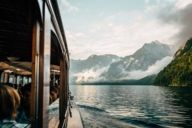
Emerald green water at the foot of the legendary Watzmann-Ostwand (Watzmann east face) – taking a trip to Königssee lake in Berchtesgaden National Park is to enjoy a singular natural experience.
- Boat trip on the Königssee
- St. Bartholomä
- Places of interest around the Königssee
- Königssee: How to get there from Munich
The imposing cliffs of the Berchtesgaden Alps decline almost vertically to the banks of the lake, which is 192 metres at its deepest point – which is why there are hardly any hiking routes directly at the water’s edge.
Anyone wanting to discover the impressive scenery surrounding what is probably the best-known mountain lake in Germany, has to travel by boat – and will be rewarded with an echo.
As soon as you set foot on board one of the electrically-driven ships, all the stress, noise, and hustle and bustle are left behind you on land. After a few minutes, the boatman stops the ship and uses a trumpet to demonstrate the world-famous echo from the steep Königssee rock face.
The echo is as much a part of the Königssee boat trip as the quiet electric engines that have driven the fleet for a good 100 years. In high season, one of the 18 boats leaves the landing at Seelände every 10 minutes, transporting up to 5,000 passengers per day.
After around half an hour, the boat moors at the St. Bartholomä peninsula behind which the vast Watzmann east face towers. The pilgrimage church in St. Bartholomä, founded in 1134, is imposing and impressive with its famous wine-red bulbous spire.
The Jagdschloss der Wittelsbacher (Wittelsbacher Hunting Château), today a guesthouse, is certainly worth seeing. Visitors can buy local Bavarian food at the site today.
A side trip to the 400-year-old smokehouse is also recommended. According to tradition, this was where fishermen from Königssee made “schwarzreiter” (black riders) from small Arctic char, by smoking them over birchwood – a speciality which is unique to Königssee to this day.
Visitors can take part in a landscape tour at St. Bartholomä, or explore the unusual animals and plants on the peninsula with the help of a National Park ranger. There is an overview of options and dates provided on-site in the National Park information office, and online at nationalpark-berchtesgaden.de (in German).
And it’s not just tourists who travel over Königssee: early every summer, cows are also transported by boat to the succulent pastures in the National Park.
Anyone interested can continue their boat journey for another 20 minutes to reach the Salet stop. This is towards the end of the eight-kilometre-long Königssee lake and at the entrance to the natural paradise of Berchtesgaden National Park. First you reach Obersee lake, which was once separated from Königssee by a moraine.
From the southern end of Obersee, it’s then around another 30 minutes on foot to the Röthbach waterfall, the tallest of its type in Germany: masses of water cascades down the rocks from a height of over 400 metres.
If needed, boats can also stop at the basin for mountain climbers, as anyone in good enough physical condition can take the path from here to the idyllic Königsbachalm alpine pasture (1,200 metres), and then hike onto the Gotzenalm pasture (1,685 metres). This tour is an absolutely classic route in the Berchtesgaden area.
And it’s not just tourists who travel over Königssee: early every summer, cows are also transported by boat to the succulent pastures in the National Park, to return over the water to their home stables at the end of the season.
Once they have solid ground under their hooves again, they are lavishly decorated amid considerable festivities. Anyone who would like to accompany the unusual “Almabtrieb” journey from the pastures can do so at the beginning of October.
Tip: Anyone planning a day trip to Berchtesgaden should rise early, as the trip from Munich takes around two hours.
Train connection: approx. 3 hours to Berchtesgaden and then by bus to Schönau am Königssee. Information at bahn.de
Car: approx. 2.5 hours via the A8 motorway